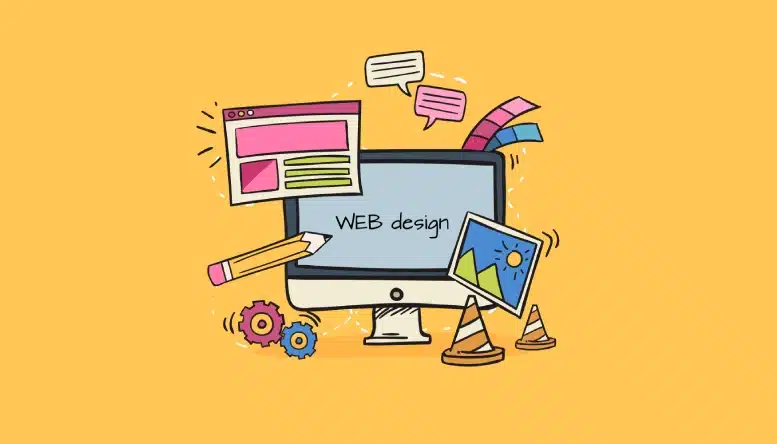Las Vegas Web Design Experts Tailored for Businesses of All Sizes
Las Vegas Web Design Experts Tailored for Businesses of All Sizes
Blog Article
Imaginative Internet Layout Solutions for Modern and Engaging Sites
In the realm of web style, the quest of contemporary and appealing options has actually come to be significantly crucial for companies aiming to catch individual attention. By integrating strong shade plans, interactive aspects, and responsive designs, developers can develop experiences that not just reverberate with users yet additionally improve brand name identification.
Embracing Strong Color Pattern
In internet design, the calculated usage of vibrant shade schemes can significantly boost individual interaction and brand name identification. By utilizing dynamic tones, designers can create visually striking web sites that capture attention and foster a memorable experience. An appropriate color scheme not only reflects a company's values however additionally stimulates certain feelings that can affect user actions.
Bold colors can be used to guide customers' focus to crucial elements such as contact us to activity, improving conversion rates. Making use of contrasting shades for buttons and web links can make these aspects stand out, prompting customers to communicate even more readily. In addition, a cohesive color design throughout the web site strengthens brand name acknowledgment, developing a sense of knowledge and depend on among site visitors.
Nonetheless, it is critical to stabilize bold colors with appropriate white room to avoid frustrating users. Efficient usage of typography likewise enhances vibrant shades, ensuring readability while keeping aesthetic allure. Eventually, accepting vibrant color systems in web layout not just raises visual high quality however also plays an indispensable function in attaining critical service purposes, making it a necessary factor to consider for contemporary internet development.

Utilizing Interactive Aspects
Interactive elements are essential in modern-day website design, as they substantially enhance user involvement and produce a more dynamic browsing experience. By including attributes such as animations, hover impacts, and clickable aspects, internet sites can encourage customers to check out content extra extensively and return for future visits.

Micro-interactions, such as refined computer animations when a switch is clicked or a form is sent, can additionally improve the user experience by giving instant responses. These small information can make the site feel even more receptive and active, cultivating a sense of connection in between users and the site.
Moreover, gamification aspects, such as benefits for finishing certain actions, can encourage individuals to involve with the material more deeply. By thoughtfully integrating these interactive elements, internet designers can produce a memorable and interesting online experience that resonates with individuals and motivates them to return.
Executing Receptive Design
Implementing receptive layout is essential in today's multi-device landscape, making certain that sites provide an ideal viewing experience across numerous display dimensions. As customers progressively access the internet through smart devices, tablet computers, and desktops, a one-size-fits-all method is no more viable. Responsive style permits seamless navigation and interaction, adjusting format and web content to fit the tool being used.
Key principles of responsive layout include fluid grids, adaptable photos, and media queries. Media inquiries help with the application of different styles based on the device's qualities, such as size, elevation, or resolution, allowing designers to customize the user experience properly.
Furthermore, responsive design improves search engine optimization performance, as internet search engine prefer mobile-friendly websites. By implementing responsive design, businesses not just improve customer fulfillment and engagement yet also raise their reach in a competitive electronic landscape. As modern technology continues to evolve, embracing responsive layout has ended up being a basic technique for any contemporary and engaging web site.
Integrating Multimedia Content
Multimedia content plays a vital duty in producing interesting and dynamic internet experiences that record users' interest and improve understanding. By incorporating message, pictures, sound, and video clip, sites can offer a richer narrative that charms to numerous finding out styles and preferences. This combination not just bolsters user engagement but additionally aids in sharing intricate concepts succinctly.
Including high-quality images and infographics can separate textual content, making it more absorbable. Similarly, video clip tutorials and presentations can offer comprehensive insights that fixed web content may not totally communicate. Audio elements, such as podcasts or background songs, can additionally boost the environment of a web site, creating a much more immersive experience.
Additionally, the strategic use multimedia can improve search engine optimization efficiency, as online search engine prefer varied web content kinds, boosting presence. However, it is critical to guarantee that multimedia aspects do not prevent web page lots times, as this can lead to individual frustration. By stabilizing multimedia assimilation with efficiency considerations, internet designers can develop aesthetically attractive and useful web sites that resonate with users, fostering a deeper link and motivating return brows through.
Prioritizing User Experience

To accomplish an optimum user experience, developers need to concentrate on numerous essential principles. Initially, receptive style is important; websites need to adjust perfectly to different devices and screen sizes. This availability guarantees that customers can engage with material despite their chosen platform. Secondly, clarity in format and pecking order is important. Clear calls to activity, readable typography, and organized content guide individuals, reducing cognitive lots.
Eventually, prioritizing UX not just elevates individual satisfaction yet also drives interaction and conversion rates, look at here now making it an important element of contemporary web style strategies. By positioning individuals at the facility of layout efforts, websites can produce long lasting, favorable impacts that urge return gos to.
Final Thought
Finally, modern website design services that click over here emphasize strong color plans, interactive elements, responsive layout, and multimedia web content significantly boost individual interaction and contentment. Focusing on customer experience via clear layouts and constant responses further adds to enhanced conversion prices. By embracing these methods, internet sites can successfully captivate site visitors and reinforce brand identity, ultimately bring about a much more dynamic and engaging on the internet presence. The integration of these layout principles is vital for achieving modern web layout purposes.
Report this page